- Italy Tours Home
- Italy Ethos
- Tours 2023
- Blog
- Contact Us
- Dolomites
- Top 10 Dolomites
- Veneto
- Dolomites Geology
- Dolomiti Bellunesi
- Cortina
- Cadore
- Belluno
- Cansiglio
- Carso
- Carnia
- Sauris
- Friuli
- Trentino
- Ethnographic Museums
- Monte Baldo
- South Tyrol
- Alta Pusteria
- Dobbiaco
- Emilia-Romagna
- Aosta Valley
- Cinque Terre
- Portofino
- Northern Apennines
- Southern Apennines
- Italian Botanical Gardens
- Padua Botanical Garden
- Orchids of Italy
Feltre: a Jewel of Renaissance
Art, and Gateway to the Vette Feltrine.
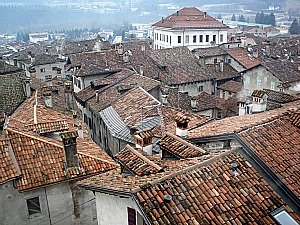
Feltre and its region cover the south-western
section of the Province of Belluno,
and this area has historically always remarked its individuality.
As usual in Italy, with regards to such matters, there are some good reasons for that diversity, as the city’s Rhaetian origins (in Pre-Roman times) marked right from the start a difference from the ancient Venetian settlement of its ‘rival’ Belluno. The town has always been at an important crossroads, and was later inhabited by the Etruscans and the Celts, only to be eventually conquered by the Romans. In 1404 it became part of the Venetian Republic.
The historical centre of Feltre is built on a steep hill that dominates its surroundings, which makes its turreted skyline an unmistakable – and almost magical – landmark from all directions (below, a view over the roofs of the old town).
Feltre lies just a short distance inland from the Piave – the region’s longest river – and at one of the extremities of the Val Belluna, the open section of valley at whose other end, about 25km to the north-east, is the city of Belluno – the provincial capital.
Despite the short distance, the difference between the two towns is quite striking. Even though both towns have an historic part dating to the time of the Venetian domination, Belluno has also developed into a modern centre, in line with the demands of being the administrative capital of the province.
Feltre, on the contrary, has retained a more intimate scale – despite being a town of around 20,000; the point is, though, that by being more relevant monumentally as well as the seat of a small University, it has focused on its cultural life more than its counterpart, making it a very active centre for its dimensions.
Its architectural integrity is also due to the fact that Feltre was completely rebuilt in the 16th century, after being destroyed in 1510 by foreign troops because of its allegiance to Venice.
This called for a harmonious rebuilding programme that was generously masterminded by Venice itself. In fact, the “Most Serene” Republic saw to it that the city be rebuilt in its former glory – better, actually, as if before the centre would have appeared Medieval and Gothic (and therefore ‘old’), now it could take on a more fashionable Renaissance outlook that turned Feltre into a modern and stylish city for its times.
This is evident still today, as every street and alleyway of Feltre’s historical centre exudes a consistent air of elegance which totally justifies the description of “Urbino of the North”. Another appropriate epithet is “Urbs picta”, that translated from the Latin literally reads as “painted city” – which, in a nutshell, is pretty much what it is (below, the detail of a house on via Mezzaterra).
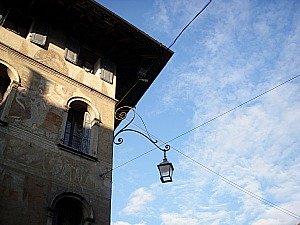
Walk along via Mezzaterra and via Lorenzo Luzzo – the main thoroughfare, crossing the historical quarter from end to end – and you’ll understand why.
You will be stunned at the quality (and quantity) of frescoes that cover the façades of most houses and palaces.
Via Mezzaterra can be accessed from the Porta Imperiale – the so-called ‘Imperial Gate’, erected in the form of a classical triumphal arch as a majestic entrance to the marvels that follow.
From then on, via Mezzaterra climbs quietly uphill, lined on both sides by an unbelievable sequence of Renaissance ‘palazzi’ that make it look, more than a street, like a theatrical backdrop that could fit one of Palladio’s creations.
That was indeed the time, in fact, and Palladio himself had his hand in the reconstruction of Feltre: his influence can be detected in some parts of the Palazzo della Ragione, built between 1548 and 1570, whose rustic portico is attributed to the great architecture master himself.
In the interior of this building – articulated on three levels and hosting today the Town Hall – there is a real hidden jewel, the Teatro della Sena: a 17th century theatre where the renowned playwright Goldoni is said to have originally performed his early works in person.
This building lies at the top of the hill on which the historical part of Feltre is located, which eventually opens up in a monumental yet serene square at the end of the steady but gentle rise of via Mezzaterra (or of the equally beautiful via Luzzo, should you climb from the other side).
This open, airy space is known as Piazza Maggiore – quite simply the ‘Main Square’ (see picture below). Articulated on several levels, this noble space gathers a cluster of notable architectures and sights.
Other than the Palazzo della Ragione – which we have already mentioned above – there are here two standing monuments (one dedicated to Vittorino da Feltre, educator and humanist; the other to Panfilo Castaldi, doctor and typographer), a St. Mark’s lion statue – sealing the allegiance of the town to Venice in the 15th century – and the Neo-Gothic architecture of Palazzo Guarnieri, erected by architect Giuseppe Segusini in the 1800s (a household name of his time, within the Province of Belluno).
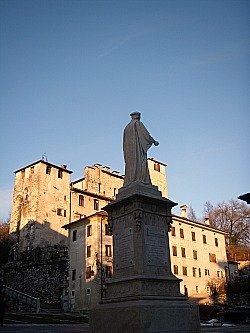
Once there, you cannot help but being struck by the fact that this square is so open and airy, and yet so tranquil and empty. This is because during the 19th century the hub of modern life shifted downtown, in the area just out of the centre and along the city walls (more on this in a minute). Undoubtedly, this is the very fact that gives Piazza Maggiore a lot of its unique charm.
Higher up, above the long fountain known as Fontana Lombardesca, the square is visually framed by the simple Renaissance façade of the church of San Rocco (1576), while further up still, the turreted outline of the Castle crowns the scene.
A narrow, cobbled alleyway ascends to the summit of the hill among beautiful old houses, and leads to the courtyard of the so-called Castello di Alboino (below, a view of the castle), once an important military stronghold, from which the views open up on the Vette Feltrine to the north and on the open corridor of the Val Belluna to the east, dominated by Monte Serva (2,133 m) and the distant mountains of Alpago.
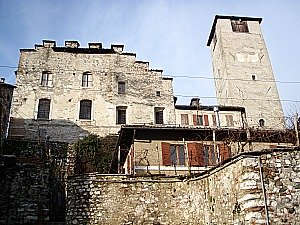
From the top of the hill, you can make a round walk, and descend using the Salita Giovanni da Vidor, undoubtedly one of the most atmospheric spots – and certainly my favourite street – in Feltre.
This is a particularly evocative corner of the old town: a tiny, traffic-free cobbled alleyway among stone walls, lined with old houses and pretty little gardens. It will take you down to another street with a poetic name, via Paradiso (‘Paradise Street’), where two other notable sights of Feltre are to be found.
The “Galleria d’Arte Moderna Carlo Rizzarda” is the local a museum of modern art, while the Museo Diocesano displays a collection of sacred art that belongs to the Diocese.
In fact, there is also a third museum – the Museo Civico (Civic Museum) – right at the end of via Luzzo, close to the other historic gate of Feltre, Porta Oria (the image below refers to the courtyard of the Museo Diocesano).
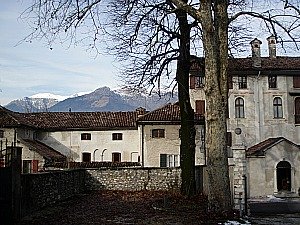
All three museums have very interesting and diversified collections, and are high-quality cultural resources for the city of Feltre – especially precious, to the occasional visitor, on rainy days (which are not so infrequent: the annual average here is of about 1800mm).
At the museum of modern art the tradition of working wrought-iron is well documented, specifically through the output of Carlo Rizzarda, a notable local 20th century artist, representative of something of an Italian Arts and Crafts movement (here known as Liberty style).
His intriguing production is on display, alongside with a collection of paintings, mostly from the local landscape school – which owes a lot in style to the Austrian Secessionism and Expressionism – but there are also works by the Tuscan Macchiaioli and the Italian modern school.
As this was the mansion where Rizzarda lived, it makes for an interesting visit for the ambiance too, with an original collection of pieces of furniture from his time, often designed by the man himself (below, a view over the roofs of historic Feltre from the museum).
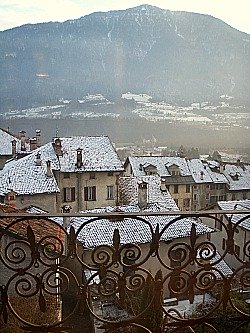
Very different is the dominant tone of the Museo Diocesano, holding a relatively small but incomparably high quality collection of religious art, whose highlights are two pieces: one is the so-called Chalice of the Deacon Orso (“Calice del Diacono Orso”) – a stunning piece of treasury dating to the 6th century, and considered to be the oldest Eucharistic chalice in the Western world.
The other masterpiece is the moving Assumption of the Virgin carved in cirmolo (Pinus cembra; Arolla pine) wood by renowned Bellunese sculptor Andrea Brustolon (1662-1732). This wooden sculpture is so graceful that it seems to be floating in mid-air – making you easily forget that this is wood, after all (see image below).
Many of the rooms of the Museo Diocesano are also atmospherically frescoed, as this was the residence of the local Viscounts from the 13th to the 17th century.
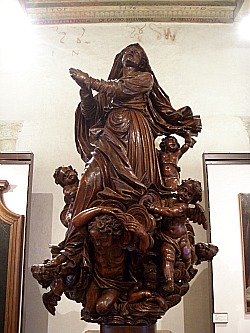
Lastly, the Civic Museum hosts an important archeological section, and it offers an overview of the Venetian school of painting from the 15th right through to the 19th century, alongside a collection of old furniture.
A section of the Civic museum is also intended to document the interiors of a typical Feltre house (“Casa Feltrina”), and the reconstruction of an old kitchen is particularly evocative.
In fact, to a different degree, all three museums are noteworthy also in terms of the buildings in which they are hosted, as they offer a great opportunity to enter three different mansions of monumental standing in Feltre.
Outside the perimeter of the walled town, just slightly off the promenade of Campo Mosto and Campo Giorgio (known as the Listòn) – that runs along the city walls with enchanting views on the old town above – is another monumental compound, grouping the Cathedral, the Baptistery and the archeological area (below, an image of the city walls, along the Listòn).
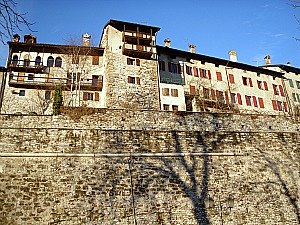
The Cathedral (pictured below), dedicated to Saint Peter, was erected in Renaissance style between 1514 and 1585; its highlight is an invaluable byzantine Cross in boxwood depicting 52 scenes of the Old Testament, carved in 542AD and safely stored in the sacristy (but you can ask to view it).
There are also many other notable works of art inside the Cathedral – especially paintings and sculptures of the Venetian school, plus an atmospheric Romanesque crypt (dating to the 11th century).
The extensive foundations (about 1000 square m) of Pre-Christian and Roman Feltre have been coming to light just on the forecourt of the Cathedral and can be visited, providing an excellent overview on the different layers that go to form the city’s complex history.
Tucked away behind the Cathedral is also the Baptistery, an harmonious little building also dating to the 16/17th century – like most of the rest of historic Feltre.
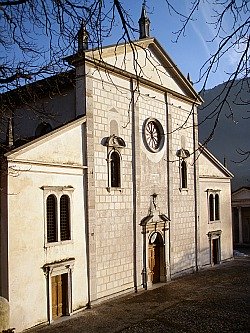
Past the Cathedral compound one reaches Largo Castaldi, which is the centre of modern-day Feltre and thrives with elegant cafés, shops and meeting places that continue along via Garibaldi and via Tezze, while if you want to head back into the historical town using a direct route, from here you can take the so-called Scalette Vecchie (Old Stairs) – a particularly atmospheric covered passage which will lead you straight back uphill to Piazza Maggiore, with enchanting views half-way up and at the top.
But as always in this area, what there is to see in town – however interesting it may be – is counterbalanced by an extensive choice of outdoor pursuits and places of natural beauty.
Just outside Feltre there is an architectural jewel not to be missed: the ancient Sanctuary of the Saints Vittore and Corona, a short distance from which (and not far from the Piave either) is also an outstanding wetland area, the Vincheto. Above the Sanctuary, there is also an interesting Nature Trail that is being described below.
Further afield, nature and art keep mingling: a breathtaking area of outstanding natural beauty – now part of the Dolomiti Bellunesi National Park – are the Vette Feltrine, but there are interesting sights also in the Val Cismon, as well as towards Cesiomaggiore and the Val Canzoi – the latter valley also contained within the boundaries of the Dolomiti Bellunesi National Park. Parts of the middle section of the Piave valley – the so-called Val Belluna – also contain some notable sights.
The Nature Trail on Monte Miesna (San Vittore Nature Trail)
The area of the Rocchetta (about 600 m) on Monte Miesna is of extraordinary importance from the viewpoint of its flora, whose peculiarities have been well-documented, in particular by local botanist Cesare Lasen, who has written several contributions for specialists’ reviews and journals, including an article dedicated to the description of a new species, the grass Stipa feltrina. Additionally, there are the information — contributed by several authors — that can be found in the small volume entirely dedicated to the “Sentiero Natura San Vittore” (San Vittore Nature Trail).
The research on the flora carried out over the last few years has confirmed and enriched the already copious list of rare species, and of those of phyto-geographic interest. The presence of fresh, mesophile woodland at the base of the Rocchetta, and of arid-steppic meadows on the ridge over the Basilica — as well as the peculiar geographic position, and the post-glacial events — have made this area of considerable naturalistic interest, so much that for certain plant species, this is the only site where they can be found in the entire province of Belluno, and among the few in the Veneto. Here follows the description of some of the most notable species that can be seen in the area of the Rocchetta on Monte Miesna:
— Bulbocodium vernum L. This a beautiful plant belonging to the Liliaceae family, with a very early blossoming (February-beginning of March), very similar to an Autumn Crocus (Colchicum sp.) in outlook. This is the only locality in the whole of the Veneto for this species, and the easternmost station on the southern side of the Alps: the small population present on the arid meadows of the Rocchetta deserves therefore a lot of attention.
— Stipa feltrina (Moraldo, Lasen & Argenti). This is a new species that has recently been described; it had already been found and sampled in 1984, but it has been identified as an autonomous entity only following many verifications. Its area of diffusion is limited to the south-easterly slope of the Rocchetta. It is a very rare example of a punctual endemic species, which significantly increases the value of this site.
— Helianthemum apenninum (L.) Mill. This plant presents woody stems at the base and large white flowers, with a conspicuous yellow blotch at the center. In the province of Belluno, besides here, it can also be found on the arid-stony craggy meadows of Pedesalto, in the municipality of Fonzaso, as well as on the cliffs uphill of the road to Arsié. These stations are the north-easternmost within its Mediterranean areal.
— Helianthemum canum (L.) Baugm. This is a small plant with a woody stem, crawling and contorted, with yellow-flowered blooms. It blossoms in June-July in the arid and craggy thermophile meadows of the Rocchetta, and also on Monte Aurin (north of Feltre).
— Ruta graveolens L. It is a perennial plant, about 50-80 cm tall, with a wooded stem at the base. The glaucous-green leaves emanate an intense and aromatic scent. Its diffusion within this area is perhaps to be connected to the cultivation of this species for pharmaceutical purposes, and linked with the presence of the monks. In an analogous way, in the proximity of the Basilica, is present — and by now naturalized — Absinth (Artemisia absinthium).
— Inula spiraeifolia L. This is a plant belonging to the Compositae family, with vivid yellow-flowered blooms. It is present at the margin of woodland thickets in hot-arid locations, and it blossoms between August and September.
— Allium sphaerocephalon L. This plant, also belonging to the Liliaceae family, is very conspicuous for its blooms and for its typical spheric inflorescence, of a dark purple-red colour. It blossoms between June and August.
— Corydalis solida (L.) Clairv. This is a herbaceous plant that blossoms in the understory during the months of March-April, before the setting out of leaves (foliation) in the woodland (same as it happens to all other geophytes, including Snowdrop, Anemones, and other species such as Gagea lutea). This plant is very similar to the more common Corydalis cava, and sometimes they grow together.
— Orlaya grandiflora (L.) Hoffm. This is a plant belonging to the Umbelliferae family, found usually in arid-steppic locations and well recognizable for the presence of white blossoms, in which the external flowers have very large, deeply incised petals. It blooms during the months of June-July.
— Silene otites (L.) Wibel. Perennial herbaceous plant with a basal rosette, from which departs an erect, branched stem, viscous at the top. The flowers are small and rather un-conspicuous. It also grows on arid-steppic meadows.
Along the whole ridge of the Rocchetta, until the junction with the trail that leads to the summit of Monte Miesna (744 a.s.l.), are present beautiful examples of arid-steppic prairies, then meadows that develop on steep slopes among protruding rocks, over a superficial terrain, in an area that enjoys good insolation and a very dry airflow, in reason of the windy location. In this climatic setting, associated with the peculiar aspect and geographic position, occur the ideal conditions for the presence of very peculiar plant communities — especially for the province of Belluno. These meadows present several affinities with those of Carso and the Pre-Alps of Friuli, and are therefore rich in species of Eastern provenance, while — at the same time — there are also other entities of more westerly distribution (such as Pseudolysimachion spicatum, Helianthemum apenninum, and even Bulbocodium itself). The extraordinary nature of these meadows is determined — besides their intrinsic naturalistic value — also by the rich variety of blossoms that follow each other over an extended time lapse that goes from February to October. In particular, stand out the vivid yellow spring blooms of Tommasini Cinquefoil (Potentilla cinerea subsp. arenaria) and of Crawling Cytisus (Cytisus pseudoprocumbens), the blue ones of Elongated Globeflower (Globularia punctata), and — towards the end of summer — the purple-blue blossoms of Aster (Aster amellus). Very singular are the panicles of Eryingium amethystinum, with stems and bracts — at the base of the inflorescence — of an amethystine purple-blue color.
On these slopes also grow several aromatic species, typical of the Mediterranean flora, amongst which stand out Common Rue (Ruta graveolens), Winter Savory (Satureja montana), Oregano (Origanum vulgare), Thyme (Thymus spp.), etc. In the herbaceous layer, with rocky outcrops, one can instead admire Houseleek (Sempervivum tectorum), with large rosettes of fleshy leaves and a showy pink-purple inflorescence, as well as the saxifrage Saxifraga hostii, which like many others saxifrages has glands that secrete limescale in excess, which is being accumulated in the leaves. The extension of these meadows has progressively reduced over the course of the years, because of the re-colonization of the woodland, mainly due to the growth of Hop Hornbeam (Ostrya carpinifolia), Manna Ash (Fraxinus ornus) and Hazel (Corylus avellana). In the areas more in proximity of the woodland, are present also plant communities typical of the margins; species here include Geranium sanguineum, with vivid purple flowers, Inula spiraeifolia and White Swallow-wort (Vincetoxicum hirundinaria). In the absence of proper management (meadows mowing and animal grazing, especially from sheep), we will have more and more the complete encroachment of woodland — even though not in rapid times, because of the windy location.
In the area of the Rocchetta are widespread — in relation to the morphologic characteristics of the area — both woodlands of the mesophile type (that do not tolerate excesses in the main ecological factors, such as temperature, rainfall, etc) and of the termophile type, the latter localized in the warmer areas. The first type is present on the slope under the Basilica, and it is dominated by Hornbeam (Carpinus betulus), but also enriched by other broadleaved, in particular Common Ash (Fraxinus excelsior), Sycamore Maple (Acer pseudoplatanus), Field Maple (Acer campestre), Mountain Elm (Ulmus glabra) and the Limes (Tilia platyphyllos and T. cordata). The understory is very rich in geophytes; that is, plants which have the characteristic of surviving the adverse season — which in our climates is winter — with subterranean organs (bulbs, roots, tubers). Among the most interesting species, in this sense, stand out the Anemones, which form white (the main species are Anemone nemorosa and A. trifolia) and yellow (A. ranunculoides) carpets, but present here is also Snowdrop (Galanthus nivalis), which is among the first plants to appear at snowmelt. Other species include Lords-and-Ladies (Arum maculatum), with mottled leaves, and the Solomon’s Seals (Polygonatum multiflorum and P. odoratum). Among the splashes of white and yellow of the Anemones, here and there one can observe also the white and purple blossoms of the more common Corydalis cava and of the rarer Corydalis solida (both with a long spur, folded backwards). This fresh environment also favours the presence, in the understory, of wild Asparagus (A. tenuifolius), quite uncommon in the province of Belluno, and of Goat’s Beard (Aruncus dioicus). Some ferns are visible too, amongst which the most characteristic is perhaps Hart’s Tongue (Phyllitis scolopendrium), which is the only fern with an undivided frond, but present are also Male Fern (Dryopteris filix-mas) and the rarer Black Spleenwort (Asplenium adiantum-nigrum), an indicator of acidified soils. Another species quite widespread in the area is Alpine Barrenwort (Epimedium alpinum), which forms extended, almost mono-specific patches, while among the numerous shrubs present, perhaps the most characteristic is Spindle (Euonymus sp.), with their singular and poisonous pink fruits, amongst which is Common Spindle (E. europaeus) and the less frequent E. latifolia, with showy, larger glossy leaves.
The termophile woodlands, instead, are to be found above the Basilica, and are characterized by the abundance of Hop Hornbeam (Ostrya carpinifolia), Manna Ash (Fraxinus ornus) and Pubescent Oak (Quercus pubescens). Among the tree species is present also Mountain Service, or Whitebeam (Sorbus aria), with leaves that are white and hairy underneath (hence the name) and red fruits. The understory is very rich and articulated, with shrubs such as Common Privet (Ligustrum vulgare), Wayfarer’s Tree (Viburnum lantana), and — above all — Cornelian Cherry (Cornus mas), which is probably the first to bloom, as early as March. Among the herbaceous species is present Liverwort (Hepatica nobilis), with trilobate leaves and flowers of a metallic purple colour. There are also other more common species, such as Primrose (Primula vulgaris); in particular, during April, stand out the purple blossoms of Lesser Periwinkle (Vinca minor). Amongst the less common herbaceous species, one can instead mention Greater Stitchwort (Stellaria holostea), with long, pointed leaves and deeply incised white flowers; additionally, Dog’s Tooth Violet (Erythronium dens-canis) can be seen too, which can easily be recognized for the single pink flower, and the presence of two long, fleshy mottled leaves with purple blotches.
The Chestnut Trail
This short circular trail includes the areas known as Costa Solana and Case Biasetto, and crosses one of the most beautiful stretches of the countryside around Feltre. The trail is partly superimposed on the thematic itinerary Chiesette pedemontane (‘Churches at the Foothills of the Alps’): a long-distance trail developed by the Park which crosses it in its extension west to east along the foothills, linking little churches and chapels, and which today, in some of its sections, consitutes also part of another long-distance itinerary, the Cammino delle Dolomiti. The boards and signs for this trail ‘at the Park’s Gateway’ focuses on some peculiar aspects and elements of the landscape and its vegetation, and uncovers some curiosities on the animals that inhabit these lands too. The southern slopes of the Vette Feltrine and Monte San Mauro act as backdrop for an easy trail suitable for all abilities and indicated also for families, which can be walked in less than 2 hours.
The Chestnut: a Recovered Tree
We will encounter many specimens of chestnut along our path: a tree that was once essential to the local economy of many hilly and mountanous areas throughout Italy, most notably in the lower reaches of the Alps and in the Apennines. Apart from the wood that it provided, it would also bring chestnuts: a starchy fruit that could be dried and also turned into flour, and thus well-preserved. This is why the diffusion of this plant was favoured by man, and dates back to the time of Greeks and Romans, who discovered it in the basin of the Black Sea, and took it throughout Europe even before the Quaternary glaciations (which ended about 10,000 years ago). The glaciations would have gradually reduced the area where chestnut grew, confining it to Asia Minor. In fact, more recent studes have suggested that chestnut was already present in Europe before the Quaternary glaciations; therefore, it is not the case of an invasive plant, but of a former resident of our woods that was brought back by the Romans, after cold and ice had forced it to seek refuge in warmer areas. Before we leave, we can observe an interesting enclosure (or pen) that was built by lining up sheets of limestone. Structures of this kind are rather rare in the area of Feltre, but can be seen in other mountainous areas of Veneto; in Lessinia, for example, the pastures were marked and limited by sheets of Lessinia stone -- the same used to build the Arena in Verona.
A Natural Monument
At one point along the trail, one can admire a majestic chestnut tree. There are many monumental chestnut trees in Italy; some of great historic and lanscape value. One of the greatest chestnuts is the Castagno dei Cento Cavalli (Chestnut of the Hundred Horses), and it is actually in Sicily. It is one of the oldest in Europe, and it is stands at the foothills of Mt. Etna. It has a girth of 22 m, and an estimated age between 2,000 and 4,000 years. The chestnut trees found in the Feltre area are famous for the typical production of moroni, renowned for the sweetness of its fruits and the floury, starchy consistency, compact and resilient to cooking. The morone from Feltre can be told apart from the other varieties for the ovoid form of the fruit, with velvety hairs and the small fringe at the apex, the torch, which makes it rather distinctive. The chestnuts can be roasted, baked or used in the classic recipe for chestnut stew. This traditional farming produce is protected and promoted by a local Co-op., the Consorzio Tutela del Morone e Castagno Feltrino. Born in 1996, this consortium unites chestnut farmers, supervises the productions, gathers the product, looks after its promotion and the marketing, as well as carrying out interventions for the recovery and improvement of the chestnut groves.
Of Owls and Other Animals
Traditional rural areas, such as the one we are crossing, are formed by a rich mosaic of different habitats, in which cultivated fields, hedges, woods and groves, orchards and meadows alternate. These very diverse environments are the preferred habitat of a small nocturnal bird of prey: the Owl (Athene noctua). It is not by chance that this bird is much more often spotted outside the park, rather than inside it, as there are more farmed lands outside the park’s boundaries. This goes to confirm, once again, that the areas ‘at the Park’s Gateway’ are very important for conserving biodiversity, and must be adequately protected too. In these environments live in fact many animal species, such as badger, hedgehog, fox and squirrel. The Owl is carnivorous, and it feeds on small vertebrates and large insects. As all nocturnal birds of prey, it swallows its prey whole, to then regurgitate the indigested parts in pellets made of fur, feathers, bones, teeth, and the exoskeleton of insects. Popular tradition unjustly considers the Owl a bearer of bad omen, while in ancient Greece this bird was considered scared to Athena, Goddess of Wisdom, from which the animal also derives its scientific name.
The Green Woodpecker: A Cheerful Fellow Countryman
A giggle from the trees, a red tuft and green plumage. You can’t miss him, it’s really him: the Green Woodpecker. It lives in the woods where it is consistently busy drilling holes in partially rotted tree trunks; it never tires to drill his way into healthy trunks. These are the words used by the Belluno-born naturalist Tommaso Antonio Catullo to define this colourful and rowdy bird, in 1838. The Green Woodpecker (Picus viridis) is common in the hills and mid-mountain areas, in which woods filled with broad-leaved deciduous trees alternate with open spaces. If the trees are large enough, all that drilling, with their sturdy beak, will result in carving a nest. The woodpecker will only leave the heights of a tree in order to feed. If you look around carefully, you can notice one of the large holes drilled by the Green Woodpecker into a tree nearby. This species is widespread in the Belluno province in the valley bottoms, and on the hillsides. It disappears, instead, from the very narrow valleys and dense forests. As a matter of fact, it hardly ever penetrates in the territory of the Park, but it is rather widespread in the farming areas surrounding the protected area, and thus it can be more easily spotted ‘at the Park’s Gateway’. Like all woodpeckers, it is a sedentary bird.
The following parts come from the trail: ‘Meadows and Woodlands Above Norcen’
Rural (or Farming) Architecture
By proceeding uphill along the trail one meets a few rural settlements, which were partly lived in throughout the year, and others that were used only as temporary shelters during springtime. From the month of May (maggio in Italian), in fact, derives the local term majolera, which would designate a group of buildings, and in general the area where one would keep the livestock, before movig onwards to the high altitude pastures for the summer period. Generally speaking, the majolera was composed of a barn/hayloft and a casera (dairy), where would be gathered and worked milk and milk produce (most notably, butter and cheese). In some cases, also, survive the traces of a particular architectural type: the casa a gradoni, perhaps of ancient German origin, whose facades present, precisely, a scaled (or graded) outlook, also referred to as casa a scalinele, and which, in successive times, have sometimes been transformed into the more usual pitched roof. The presence of frequent rocky limestone outcrops (scaglia rossa, biancone) guaranteed the availability of building material, to be used both for the walls, for the scales on the roof, and for the rest of the covering. The more resilient rocks, such as porphyry, for instance, were perfect as cornerstones. But how can one explain the presence of a volcanic rock such as porphyry in this area? We will discover it at one of our next stops!
The Erratics: Heritage of the Ice Age
What are these dark masses or rock doing here? It isn't limestone, and it’s not Dolostone either -- it is a stone that has nothing to do with the ones that can be found in the mountains nearby; these are boulders that come from far away: from mountains of volcanic origin, located in Trentino. To understand how these boulders got here, we have to go back at least 15,000 years ago, when the last Ice Age was about to end, and a huge glacial strip descended into the Cismon valley, and eventually in the Piave valley, after having cut through the area of Croce d’Aune, as it gradually withdrew. That is how everything the glacier had stripped from the surrounding mountains and dragged along, began to deposit. Besides the glacial deposits made of finer matter, one can encounter, here and there, also huge erratic boulders, like those right here, where the masses 'aboard' the glacier ended their journey. Their dull, smoooth appearance demonstrate the extraordinary abrasive force of ice throughout the millennia. The porphyry of which many erratic boulders are made is a stone that is particularly resilient, and many thousands of years later, man learned what a treasure this heritage from the Ice Age was, by using square blocks of porphyry to build the walls of their homes and animal pens.
The Human Landscape
This portion of land -- a sub-montane band -- at the base of the mountain and ‘at the Park’s Gateway’ is where the most interesting, fascinating and best preserved human landscapes can be appreciated. Here, man has sculpted Nature into a mosaic of micro-environments: pastures, fields, orchards, hedges, small rural settlements that alternate on rolling hills, locally carved by small water courses. This landscape bears witness to the industriuosness of a sober colonization of this territory, which contributed -- amongst other things -- to increase its biodiversity. In other words, many animals and plants wouldn't even be here, if man hadn’t invented new spaces for them. The fields are an emblematic example, and must therefore be appreciated, not only for their worth in the context of the landscape, but for their naturalistic value as well. A lovely view can be admired from this location: from the north-west, over the south-facing rock layers of the Magheron peaks, all the way to the east, to the natural terraced plateau of Lamen. Lower down, on the opposite side of the valley, if you look closely, you can see forms of erosion on the fluvial-glacial deposits that resemble those of the famous earth pyramids of Segonzano (Trentino), which here are called gusele (needles) in the local dialect.
The Quarry
The houses and casera lodgings (dairies) in Norcen, and throughout the surrounding territory, bear witness to how stone was once chosen and processed; every wall is a kind of mosaic made of skilfully arranged coloured stones. People used whatever they found: stones from streams' beds or from glacial deposits, gathered near the village; resistant blocks of porphyry for the cornerstones, and, quite often, even pre-cast concrete slabs, or rock sheets obtained from layered limestone. This hamlet gets its name from a small quarry, from which a red stone was once extracted (a type of stone known as Rosso di Norcen): this was actually layered limestone, used for doorways, window sills and lintels; doorjambs and even roofs. The large slabs of stone received their first sanding here, but they were later transported to the valley floor by sled.
Return from Feltre to Italy-Tours-in-Nature
Copyright © 2012 Italy-Tours-in-Nature

New! Comments
Have your say about what you just read! Leave me a comment in the box below.